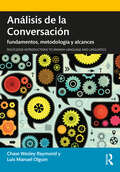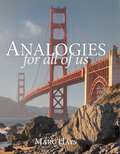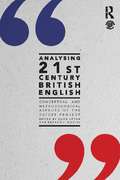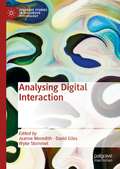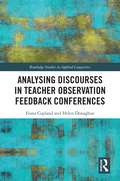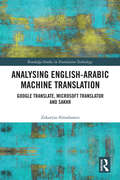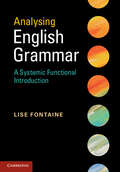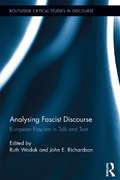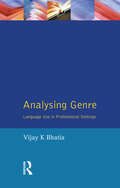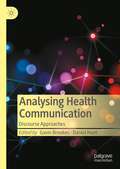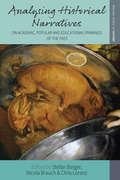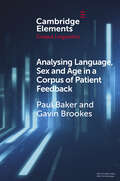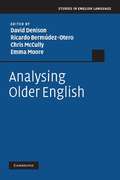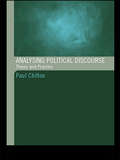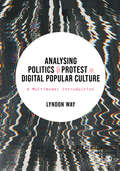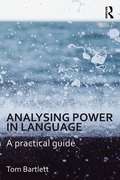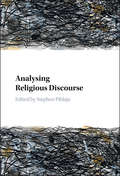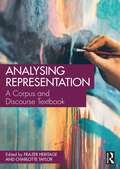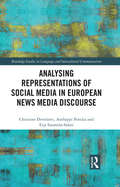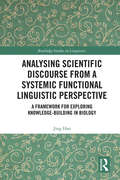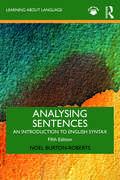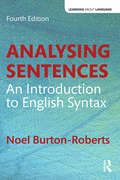- Table View
- List View
Análisis de la Conversación: fundamentos, metodología y alcances
by Chase Wesley Raymond Luis Manuel OlguínAnálisis de la Conversación: fundamentos, metodología y alcances ofrece la primera introducción comprehensiva al Análisis de la Conversación (AC) en español y con datos conversacionales disponibles en línea. El libro está organizado en nueve capítulos. En los capítulos iniciales, se presenta el AC como una disciplina y método analítico para el estudio del habla y otras formas de conducta humana en la interacción social, se hace un breve recuento histórico del desarrollo de la perspectiva analítico-conversacional y se introduce a los lectores al sistema de transcripción usado en el AC. Los capítulos siguientes están dedicados a explorar cuatro dominios claves en la organización de la conversación espontánea: la toma de turnos, las secuencias de acciones, la preferencia y la enmienda, destacando la importancia de prácticas del diseño de turno en cada dominio. Seguidamente, se discute la conexión entre organizaciones y prácticas del habla en interacción y contextos sociales e identidades de los participantes en conversación. El libro concluye ofreciendo una serie de sugerencias para la investigación analítico-conversacional en español y señalando su relevancia para la indagación de la interacción en contextos legales, políticos, médicos, tecnológicos, entre otros. Cada capítulo incluye ejemplos tomados de conversaciones auténticas en distintas variedades de español, cuyos audios pueden ser consultados directamente en línea. Con el fin de revisar y profundizar lo aprendido, cada capítulo ofrece un apartado final con preguntas, actividades y lecturas adicionales. Como apéndices al libro, se ofrecen, además, un glosario de términos bidireccional español–inglés y un sumario con las convenciones de transcripción más usadas. Escrito enteramente en español, el libro ofrece una introducción actual, comprehensiva y amigable al AC y sus aplicaciones por lo que constituye una fuente de referencia ideal para estudiantes, instructores e investigadores en lingüística (hispánica), sociología y comunicaciones. Análisis de la Conversación provides the first comprehensive, Spanish-language introduction to the field of Conversation Analysis (CA), utilizing conversational data that is publicly available online. The book is organized in nine chapters. The opening chapters introduce Conversation Analysis as a unique theory and method to study language and other forms of conduct in social interaction. Readers are presented with a history of the development of this framework for analyzing interaction and introduced to the transcription system used in CA. The following chapters explore four key domains of organization within spontaneous conversation—turn-taking, preference, sequence, and repair—highlighting the importance of turn design practices in each. The authors then review the connection of these organizations and practices to social contexts and participant identities, and they conclude by suggesting a range of avenues for future research on Spanish conversation, including its relevance in specific legal, political, medical, and technological settings. Each chapter includes a variety of examples from authentic Spanish conversation, which readers can consult directly online. Each chapter is additionally accompanied by a set of questions and activities that allow readers to check and reinforce their understanding, as well as lists of additional readings for readers interested in more specific topics. Glossaries of technical vocabulary—both Spanish-English and English-Spanish—are included as appendices, along with a summary of transcription system notation. Written entirely in Spanish, this book presents a thorough and engaging introduction to Conversation Analysis and its applications. It is ideal for students, instructors, and researchers in Hispanic Studies, (Spanish) Linguistics, Sociology, and Communication Studies.
Analogies for All of Us: A revelation in relating to your world using analogies and figures of speech
by Mac HaysDiscovering and naming relationships is central to human thinking and communication. Studying analogies gives students tools to become better thinkers and better communicators. This book includes a full semester of basic analogies instruction and practice, as well as opportunities for students to create figures of speech associated with each analogy lesson. This book is an unprecedented integration of thinking skills, writing practice, reading comprehension, poetry appreciation, and story-telling. It is self-teaching, meaning no other resources are needed; it is intended for children and parents to use together. Structured according to the rhythms of the Challenge A seminar, one day of each week contains instruction in analogies followed by four days practicing what was learned together in the Challenge A seminar.
Analysing 21st Century British English: Conceptual and Methodological Aspects of the 'Voices' Project
by Bethan L. Davies Clive UptonThe Voices project of the British Broadcasting Corporation, a recent high-profile media investigation, gathered contemporary English dialect samples from all over the UK and invited contributions from the public to a dedicated website. This book explores both issues of ideology and representation behind the media project and uses to which the emerging data can be put in the study of language variation and change. Two lead-in chapters, written from the complementary perspectives of a broadcast media specialist, Simon Elmes, and an academic linguist, David Crystal, set the project in the BBC’s historical, social, and linguistic contexts. Following these, authorities in a range of specialisms concerned with uses and representations of language varieties address various aspects of the project’s potential, in three broad sections: Linguistic explorations of the representations of language and the debates on language evoked by the data. The linguistic product of the project, including lexical, phonological, and grammatical investigations. Technical aspects of creating maps from the large electronic Voices database. An interactive companion website provides the means to access, explore, and make use of raw linguistic data, along with interpretive maps created from it, all accompanied by full explanations. Analysing 21st Century British English brings together key research and is essential reading for advanced undergraduate students, postgraduate students and researchers working in the areas of language variation, dialect and sociolinguistics. Contributors: David Crystal, Bethan Davies, Susie Dent, Simon Elmes, Holly Gilbert, Jon Herring, John Holliday, Alexandra Jaffe, Tommaso Milani, Rob Penhallurick, Jonnie Robinson, Mooniq Shaikjee, Ann Thompson, Will Turner, Clive Upton, Martijn Wieling.
Analysing Digital Interaction (Palgrave Studies in Discursive Psychology)
by David Giles Joanne Meredith Wyke StommelThis book investigates interaction-focused scholarship on online communication. It focuses on a broad range of online contexts including social media, dating apps, online comments, instant messaging and video-mediated interaction. Bringing together experts from a variety of scholarly backgrounds, chapters demonstrate how different microanalytic methods, including conversation analysis, membership categorization analysis and discursive psychology, can be applied to online communication. The book also goes on to address ethical, methodological and theoretical issues of analysing online social interaction. With the explosion of the use of online platforms for everyday and institutional interaction, this book is a timely collection which explores the current state of the field, and considers future directions for microanalysis of online communication.
Analysing Discourses in Teacher Observation Feedback Conferences (Routledge Studies in Applied Linguistics)
by Fiona Copland Helen DonaghueThis volume focuses on the post-observation feedback conference, a common feature of teacher education programs, and highlights the importance of such talk in the development and evaluation of teachers and other professionals. The book adopts a linguistic ethnographic approach, which provides a framework for examining the contextual nature of the talk and how it is embedded within wider social contexts and structures, such as evaluation regimes. Drawing on data from a range of settings, including pre-service teacher education, medical education, and teacher appraisal programs, Copland and Donaghue examine the feedback conference from a range of perspectives, including face, identity and genre, and show how a nuanced understanding of discussions can support teacher trainers, supervisors and observers to provide appropriate and useful feedback. A concluding chapter brings together brief vignettes from researchers active in the field to point to future directions for further study. This book will be of particular interest to students and researchers in discourse analysis, language education, linguistic anthropology, and professional communication, as well as pre- and in-service teachers.
Analysing English-Arabic Machine Translation: Google Translate, Microsoft Translator and Sakhr (Routledge Studies in Translation Technology)
by Zakaryia AlmahaseesMachine Translation (MT) has become widely used throughout the world as a medium of communication between those who live in different countries and speak different languages. However, translation between distant languages constitutes a challenge for machines. Therefore, translation evaluation is poised to play a significant role in the process of designing and developing effective MT systems. This book evaluates three prominent MT systems, including Google Translate, Microsoft Translator, and Sakhr, each of which provides translation between English and Arabic. In the book Almahasees scrutinizes the capacity of the three systems in dealing with translation between English and Arabic in a large corpus taken from various domains, including the United Nation (UN), the World Health Organization (WHO), the Arab League, Petra News Agency reports, and two literary texts: The Old Man and the Sea and The Prophet. The evaluation covers holistic analysis to assess the output of the three systems in terms of Translation Automation User Society (TAUS) adequacy and fluency scales. The text also looks at error analysis to evaluate the systems’ output in terms of orthography, lexis, grammar, and semantics at the entire-text level and in terms of lexis, grammar, and semantics at the collocation level. The research findings contained within this volume provide important feedback about the capabilities of the three MT systems with respect to EnglishArabic translation and paves the way for further research on such an important topic. This book will be of interest to scholars and students of translation studies and translation technology.
Analysing English Grammar
by Lise FontaineA practical step-by-step introduction to the analysis of English grammar, this book leaves the reader confident to tackle the challenges analysing grammar may pose. The first textbook to take an integrated approach to function and structure in grammatical analysis, it allows students to build experience, skills and confidence in working with grammar. The innovative, hybrid approach combines an introduction to systemic functional theory with a solid grounding in grammatical structure. The book approaches grammar in an incremental way, enabling students to develop grammatical skill in stages. It is of particular value to those starting to work with functional grammar but it is also relevant for experienced readers who are interested in developing a more systematic approach to grammatical analysis.
Analysing Fascist Discourse: European Fascism in Talk and Text (Routledge Critical Studies in Discourse #5)
by Ruth Wodak John E. RichardsonThis book focuses primarily on continuities and discontinuities of fascist politics as manifested in discourses of post-war European countries. Many traumatic pasts in Europe are linked to the experience of fascist and national-socialist regimes in the 20th century and to related colonial and imperialist expansionist politics. And yet we are again confronted with the emergence, rise and success of extreme right wing political movements, across Europe and beyond, which frequently draw on fascist and national-socialist ideologies, themes, idioms, arguments and lexical items. Post-war taboos have forced such parties, politicians and their electorate to frequently code their exclusionary fascist rhetoric. This collection shows that an interdisciplinary critical approach to fascist text and talk—subsuming all instances of meaning-making (oral, visual, written, sounds, etc.) and genres such as policy documents, speeches, school books, media reporting, posters, songs, logos and other symbols—is necessary to deconstruct exclusionary meanings and to confront their inegalitarian political projects.
Analysing Genre: Language Use in Professional Settings (Applied Linguistics and Language Study)
by V. K. BhatiaGenre analysis has a long-established tradition in literature, but interest in the analysis of non-literary genres has been very recent. This book examines the theory of genre analysis, looks at genre analysis in action, taking texts from a wide variety of genres and discusses the use of genre analysis in language teaching and language reform.
Analysing Health Communication: Discourse Approaches
by Gavin Brookes Daniel HuntThis edited book showcases original research in the study of healthcare and health communication, while also providing a detailed overview of contemporary methods of discourse analysis. Discourse approaches remain under-represented in the field of health communication, despite their potential for affording detailed understanding of health-related text and talk across an array of contexts, for example in face-to-face and digital healthcare encounters, health promotion, and patients’ accounts of illness experiences. This book aims to address this gap in the literature by offering the first book-length treatment of different approaches to discourse analysis in health(care) and illness contexts, and it will appeal both to linguists and to researchers in nursing and health sciences, sociology and anthropology.
Analysing Historical Narratives: On Academic, Popular and Educational Framings of the Past (Making Sense of History #40)
by Stefan Berger, Nicola Brauch Chris LorenzFor all of the recent debates over the methods and theoretical underpinnings of the historical profession, scholars and laypeople alike still frequently think of history in terms of storytelling. Accordingly, historians and theorists have devoted much attention to how historical narratives work, illuminating the ways they can bind together events, shape an argument and lend support to ideology. From ancient Greece to modern-day bestsellers, the studies gathered here offer a wide-ranging analysis of the textual strategies used by historians. They show how in spite of the pursuit of truth and objectivity, the ways in which historians tell their stories are inevitably conditioned by their discursive contexts.
Analysing Historical Narratives: On Academic, Popular and Educational Framings of the Past (Making Sense of History #40)
by Stefan Berger, Nicola Brauch Chris LorenzFor all of the recent debates over the methods and theoretical underpinnings of the historical profession, scholars and laypeople alike still frequently think of history in terms of storytelling. Accordingly, historians and theorists have devoted much attention to how historical narratives work, illuminating the ways they can bind together events, shape an argument and lend support to ideology. From ancient Greece to modern-day bestsellers, the studies gathered here offer a wide-ranging analysis of the textual strategies used by historians. They show how in spite of the pursuit of truth and objectivity, the ways in which historians tell their stories are inevitably conditioned by their discursive contexts.
Analysing Language, Sex and Age in a Corpus of Patient Feedback: A Comparison of Approaches (Elements in Corpus Linguistics)
by Paul Baker Gavin BrookesThis Element explores approaches to locating and examining social identity in corpora with and without the aid of demographic metadata. This is a key concern in corpus-aided studies of language and identity, and this Element sets out to explore the main challenges and affordances associated with either approach and to discern what either approach can (and cannot) show. It describes two case studies which each compare two approaches to social identity variables – sex and age – in a corpus of 14-million words of patient comments about NHS cancer services in England. The first approach utilises demographic tags to group comments according to patients' sex/age while the second involves categorising cases where patients disclose their sex/age in their comments. This Element compares the findings from either approach, with the approaches themselves being critically discussed in terms of their implications for corpus-aided studies of language and identity.
Analysing Older English
by Chris Mccully Emma Moore Ricardo Bermúdez-Otero David DenisonIs historical linguistics different in principle from other linguistic research? This book addresses problems encountered in gathering and analysing data from early English, including the incomplete nature of the evidence and the dangers of misinterpretation or over-interpretation. Even so, gaps in the data can sometimes be filled. The volume brings together a team of leading English historical linguists who have encountered such issues first-hand, to discuss and suggest solutions to a range of problems in the phonology, syntax, dialectology and onomastics of older English. The topics extend widely over the history of English, chronologically and linguistically, and include Anglo-Saxon naming practices, the phonology of the alliterative line, computational measurement of dialect similarity, dialect levelling and enregisterment in late Modern English, stress-timing in English phonology and the syntax of Old and early Modern English. The book will be of particular interest to researchers and students in English historical linguistics.
Analysing Political Discourse: Theory and Practice
by Paul ChiltonThis is an essential read for anyone interested in the way language is used in the world of politics. Based on Aristotle's premise that we are all political animals, able to use language to pursue our own ends, the book uses the theoretical framework of linguistics to explore the ways in which we think and behave politically. Contemporary and high profile case studies of politicians and other speakers are used, including an examination of the dangerous influence of a politician's words on the defendants in the Stephen Lawrence murder trial.International in its perspective, Analysing Political Discourse also considers the changing landscape of political language post-September 11, including the increasing use of religious imagery in the political discourse of, amongst others, George Bush.Written in a lively and engaging style, this book provides an essential introduction to political discourse analysis.
Analysing Politics and Protest in Digital Popular Culture: A Multimodal Introduction
by Lyndon WaySupporting you with varied features throughout, this intriguing new book provides a foundational understanding of politics and protest before focusing on step-by-step instructions for carrying out analysis on your own. It includes up to date cases, such as analysis of memes about Brexit, Trump and coronavirus, that cater for this quickly moving field.
Analysing Politics and Protest in Digital Popular Culture: A Multimodal Introduction
by Lyndon WaySupporting you with varied features throughout, this intriguing new book provides a foundational understanding of politics and protest before focusing on step-by-step instructions for carrying out analysis on your own. It includes up to date cases, such as analysis of memes about Brexit, Trump and coronavirus, that cater for this quickly moving field.
Analysing Power in Language: A practical guide
by Tom BartlettAnalysing Power in Language introduces students to a range of analytical techniques for the critical study of texts.Each section of the book provides an in-depth presentation of a different method of analysis with worked examples and texts for students to analyse and discuss. Answer keys are also provided for the analyses. Taking text analysis as the first step in discourse analysis, Analysing Power in Language: Explores the relationship between the goals of discourse, the social positions of the speakers, the contexts in which they are produced, the audience for which they are intended and the language features chosen Presents a powerful approach to text analysis that reveals the links between language usage and a community’s assumptions, convictions, and understandings Identifies a range of power types, appropriate to different contexts Explains and illustrates a social approach to text analysis with important linguistic concepts woven in seamlessly with examples of discourse Offers concrete guidance in text and discourse analysis with carefully crafted examples and fully illustrated explanations. Incisive and thought-provoking yet also accessible, Analysing Power in Language will be essential reading for advanced undergraduate, postgraduate and research students studying discourse analysis.
Analysing Religious Discourse
by Stephen PihlajaLanguage plays a key role in religion, framing how people describe spiritual experience and giving structure to religious beliefs and practices. Bringing together work from a team of world-renowned scholars, this volume introduces contemporary research on religious discourse from a variety of theoretical and methodological perspectives. It introduces methods for analysis of a range of different kinds of text and talk, including institutional discourse within organised religions, discourse around spirituality and spiritual experience within religious communities, media discourse about the role of religion and spirituality in society, translations of sacred texts, political discourse, and ritual language. Engaging and easy-to-read, it is accessible to researchers across linguistics, religious studies, and other related disciplines. A comprehensive introduction to all the major research approaches to religious language, it will become a key resource in the emerging inter-disciplinary field of language and religion.
Analysing Representation: A Corpus and Discourse Textbook
by Frazer HeritageAnalysing Representation: A Corpus and Discourse Textbook guides readers through the process of researching how people and phenomena are represented in discourse and introduces them to key tools they can use from corpus linguistics and (critical) discourse analysis. This book takes a step-by-step approach to introducing each concept and includes exercises and further reading to help readers check their progress and prepare for independent research. It is unique in introducing readers to a range of experts representing the full range of work in this area. This book is aimed at final-year undergraduate, taught postgraduate and doctoral level students. It wil also be useful to scholars who are new to combining corpus and discourse methods in investigations of representation.
Analysing Representations of Social Media in European News Media Discourse (Routledge Studies in Language and Intercultural Communication)
by Christine Develotte Anthippi Potolia Eija Suomela-SalmiThis book explores representations of social media in European media discourses across different socio-historical contexts, demonstrating how such analysis can illuminate the tension between global and local in media discourses in today’s globalised world. The volume draws on data from a trilingual corpus from different editions of the free daily Metro from Finland, France, and Greece spanning a five-year period, with a focus on Facebook and Twitter. Adopting a French discourse analysis approach, which takes as its point of departure the notion of “discourse as the social practice of representing”, the book integrates qualitative and quantitative analyses to investigate the social and political role depictions of social media play in specific socio-historical contexts. This approach brings to the fore both commonalities and differences in the popularity of specific platforms and coverage of specific news topics and hot-button issues. In so doing, the volume elucidates the ways in which global practices become integrated and immersed into local contexts, offering avenues for future research on social media in news discourses. This book will be of interest to scholars in applied linguistics, intercultural communication, discourse analysis, media studies, and cultural studies.
Analysing Scientific Discourse from A Systemic Functional Linguistic Perspective: A Framework for Exploring Knowledge Building in Biology (Routledge Studies in Linguistics)
by Jing HaoThis book describes the discourse of biology from a systemic functional linguistic perspective. It offers a detailed description of resources based on text analysis. The description reveals co-textual patterns of language features, their expressions through grammatical resources, as well as their functions in the disciplinary context. The book also applies the description to analyse student texts in undergraduate biology, revealing characteristics of language and knowledge development. Although the discussion in this book focuses on the discourse of biology, both the language description and the descriptive principle can be used to inform the examination of knowledge in academic discourse in general, making this key reading for students and researchers in systemic functional linguistics, discourse analysis, English for academic purposes, applied linguistics, and science education.
Analysing Sentences: An Introduction to English Syntax (Learning about Language)
by Noel Burton-RobertsAnalysing Sentences is an accessible and student-friendly introduction to the practical analysis of English sentence structure. The book covers key concepts such as constituency, category and functions, and uses tree diagrams throughout to help the reader visualise the structure of sentences. The fifth edition of this best-selling textbook has been thoroughly updated and revised to feature new material, new example sentences and a more reader-friendly layout. The final chapter sets the analysis in its theoretical context and includes an introduction to constituency in X-bar syntax. The book is also supported by an updated companion website featuring extra exercises for students and a complete set of answers for instructors for the online activities and exercises in the book. Accessible and clear, this book is the perfect textbook for readers coming to this topic for the first time. Featuring many in-text and end-of-chapter exercises, it is suitable for self-directed study as well as for use as core reading on introductory syntax courses.
Analysing Sentences: An Introduction to English Syntax (Learning about Language)
by Noel Burton-RobertsThis highly successful text has long been considered the standard introduction to the practical analysis of English sentence structure. It covers key concepts such as constituency, category and functions, and also utilises tree diagrams throughout to help the reader visualise the structure of sentences. In this fourth edition, Analysing Sentences has been thoroughly revised and now features a brand new companion website with additional activities and exercises for students and an answer book for the in-text exercises for professors. The extra activities on the website give students practice in identifying syntactic phenomena in running text and will help to deepen understanding of this topic. Accessible and clear, this book is the perfect textbook for readers coming to this topic for the first time. Featuring many in-text, end-of-chapter and Further Exercises, it is suitable for self-directed study as well as for use as core reading on courses.
